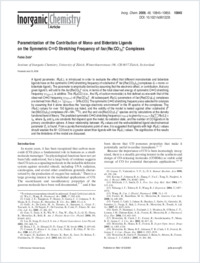Parametrization of the contribution of mono- and bidentate ligands on the symmetric C[triple bond]O stretching frequency of fac-[Re(CO)(3)](+) complexes
- Zobi, Fabio University of Fribourg
-
2009
Published in:
- Inorganic Chemistry. - 2009, vol. 48, no. 22, p. 10845-10855
Oxides
Inorganic carbon compounds
Metals
Ligands
Pyridines
Rhenium
Parametrization
Infra Red
Carbonyl
English
A ligand parameter, IR(P)(L), is introduced in order to evaluate the effect that different monodentate and bidentate ligands have on the symmetric C[triple bond]O stretching frequency of octahedral d(6) fac-[Re(CO)(3)L(3)] complexes (L = mono- or bidentate ligand). The parameter is empirically derived by assuming that the electronic effect, or contribution, that any given ligand L will add to the fac-[ReCO(3)](+) core, in terms of the total observed energy of symmetric C[triple bond]O stretching frequency (nu(CO(obs))), is additive. The IR(P)(CO) (i.e., the IR(P) of carbon monoxide) is first defined as one-sixth that of the observed C[triple bond]O frequency (nu(CO(obs))) of [Re(CO)(6)](+). All subsequent IR(P)(L) parameters of fac-[Re(CO)(3)L(3)] complexes are derived from IR(P)(L) = (1)/(3)[nu(CO(obs)) - 3IR(P)(CO)]. The symmetric C[triple bond]O stretching frequency was selected for analysis by assuming that it alone describes the "average electronic environment" in the IR spectra of the complexes. The IR(P)(L) values for over 150 ligands are listed, and the validity of the model is tested against other octahedral d(6) fac-[M(CO)(3)L(3)] complexes (M = Mn, (99)Tc, and Ru) and cis-[Re(CO)(2)L(4)](+) species and by calculations at the density functional level of theory. The predicted symmetric C[triple bond]O stretching frequency (nu(CO(cal))) is given by nu(CO(cal)) = S(R)[ sum IR(P)(L)] + I(R), where S(R) and I(R) are constants that depend upon the metal, its oxidation state, and the number of CO ligands in its primary coordination sphere. A linear relationship between IR(P) values and the well-established ligand electrochemical parameter E(L) is found. From a purely thermodynamic point of view, it is suggested that ligands with high IR(P)(L) values should weaken the M-CO bond to a greater extent than ligands with low IR(P)(L) values. The significance of the results and the limitations of the model are discussed.
- Faculty
- Faculté des sciences et de médecine
- Department
- Département de Chimie
- Language
-
- English
- Classification
- Chemistry
- License
- License undefined
- Identifiers
-
- RERO DOC 330341
- DOI 10.1021/ic901223t
- Persistent URL
- https://folia.unifr.ch/unifr/documents/309217
Statistics
Document views: 74
File downloads:
- zobi_2009_parametrization.pdf: 129
